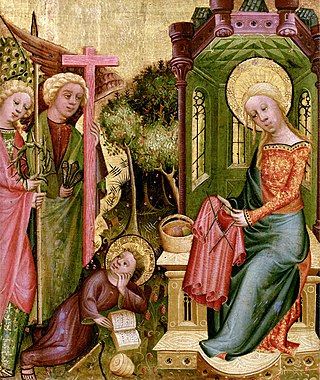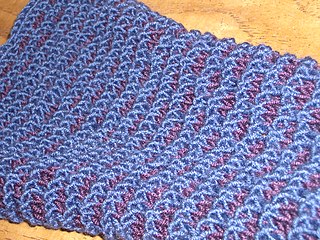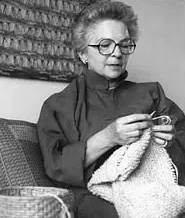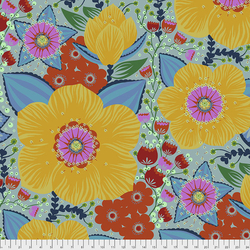Related Research Articles

Knitting is a method for production of textile fabrics by interlacing yarn loops with loops of the same or other yarns. It is used to create many types of garments. Knitting may be done by hand or by machine.

The Aran jumper, also called a fisherman's jumper, is a style of jumper that takes its name from the Aran Islands off the west coast of Ireland. A traditional Aran Jumper usually is off-white in colour, with cable patterns on the body and sleeves. Originally the jumpers were knitted using unscoured wool that retained its natural oils (lanolin) which made the garments water-resistant and meant they remained wearable even when wet.

Knitting is the process of using two or more needles to pull and loop yarn into a series of interconnected loops in order to create a finished garment or some other type of fabric. The word is derived from knot, thought to originate from the Dutch verb knutten, which is similar to the Old English cnyttan, "to knot". Its origins lie in the basic human need for clothing for protection against the elements. More recently, hand knitting has become less a necessary skill and more of a hobby.

Craftivism is a form of activism, typically incorporating elements of anti-capitalism, environmentalism, solidarity, or third-wave feminism, that is centered on practices of craft - or what has traditionally been referred to as "domestic arts". Craftivism includes, but is not limited to, various forms of needlework including yarn-bombing or cross-stitch. Craftivism is a social process of collective empowerment, action, expression and negotiation. In craftivism, engaging in the social and critical discourse around the work is central to its production and dissemination. Practitioners are known as craftivists. The word 'craftivism' is a portmanteau of the words craft and activism.
Intarsia is a knitting technique used to create patterns with multiple colours. As with the woodworking technique of the same name, fields of different colours and materials appear to be inlaid in one another, fit together like a jigsaw puzzle.
Combined knitting or combination knitting is a knitting method that combines elements of Eastern-style knitting with the Western techniques. The name was suggested by Mary Thomas in her 1938 book "Mary Thomas's Knitting Book", where she described the method as "..the better way to work in Flat Knitting. The resulting fabric is more even and closer in construction." By wrapping the yarn the opposite way while purling, the knitter changes the orientation of the resulting loops; then the next row's knit stitches can be formed by inserting the needle through the back leg, rather than through the front leg, without twisting the stitch. This method is suitable for all knitted fabrics from the basic Stockinette stitch, to any other technique, such as Fair Isle, circular knitting, or lace knitting.

Elizabeth Zimmermann was a British-born hand knitting teacher and designer. She revolutionized the modern practice of knitting through her books and instructional series on American public television.

Slip-stitch knitting is a family of knitting techniques that uses slip stitches to make multiple fabrics simultaneously, to make extra-long stitches, and/or to carry over colors from an earlier row.

Mary Walker Phillips, was an American textile artist, author and educator. She revolutionized the craft of hand knitting by exploring knitting as an independent art form. Her hand-knit tapestries and other creative pieces are exhibited in museums in the U.S. and Europe. She was honored as a fellow by the American Craft Council (ACC) in 1978.
Shannon Okey is an American writer and knit designer.
Knitty.com is an online knitting magazine, founded and edited by Amy Sadler and published quarterly since fall 2004.

Spool knitting,loom knitting, corking,French knitting, or tomboy knitting is a form of knitting that uses a spool with a number of nails or pegs around the rim to produce a tube or sheet of fabric. The spool knitting devices are called knitting spools, knitting nancys, knitting frame, knitting loom, or French knitters.
A knitting club is a social group in which knitting and crochet enthusiasts gather to do needlework together. They are a feature of the 21st-century revival of hand knitting which began in America and has spread to most of Europe. Despite the name, knitting clubs are not limited to knitting; both crochet-centered and knit-centered clubs are collectively called "knitting clubs." While knitting has never gone away completely, this latest reincarnation is less about the make-do and mend of the 1940s and 1950s, and more about making a statement about individuality and developing a sense of community.
Hand knitting is a form of knitting, in which the knitted fabric is produced by hand using needles.

Ravelry is a free social networking service and website that beta-launched in May 2007. It functions as an organizational tool for a variety of fiber arts, including knitting, crocheting, spinning and weaving. Members share projects, ideas, and their collection of yarn, fiber and tools via various components of the site.

Cowichan knitting is a form of knitting characteristic of the Cowichan people of southeastern Vancouver Island, British Columbia. The distinctively patterned, heavy-knit Cowichan sweaters, popular among British Columbians and tourists, are produced using this method. Cowichan knitting is an acculturated art form, a combination of European textile techniques and Salish spinning and weaving methods. From this union, new tools, techniques and designs developed over the years.
Norah Gaughan is an American hand knitting pattern designer.

Jorabs are multicolored socks with intricate patterns, knitted from the toe-up. They are usually worn in such a way as to display rich decoration.

Anna Maria Horner is an artist, author and fabric designer in Nashville, Tennessee, known for her colorful fabric designs, quilts, and sewing patterns. In addition to teaching classes and selling items globally under her namesake brand, she has written several books about sewing, quilting, and needlework. Horner has appeared on The Martha Stewart Show and been featured in Better Homes and Gardens. In May 2015 she opened Craft South, a craft store and studio in Nashville.
Cat Bordhi (1951-2020) was an American author, accomplished knitter, teacher, and designer.
References
- ↑ "Craft Cruises® ~ Knitting Instructors :: Crocheting Instructors :: Beading Instructors :: and more". Craft Cruises® - Craft Cruise. Retrieved 2023-08-31.
- 1 2 3 Grauvogl, Ann (February 6, 1997). "Knitting for the Fun of It". Argus Leader. Sioux Falls, SD. p. 11. Retrieved 31 August 2023.
- ↑ Thomas, Nancy (September 13, 1998). "Ethnic Styles Influence Accessories". Omaha World-Herald. p. 71. Retrieved 31 August 2023.
- ↑ Hamlin, Ardeana (April 1, 2003). "New Book Celebrates Anarchy in Knitting". The Bangor Daily News. p. 20. Retrieved 31 August 2023.
- ↑ Levisay, Benjamin. "Anna Zilboorg (07-06-2020): Elder, Author, Designer, Teacher, Knitter". Blog Talk Radio. Retrieved 31 August 2023.
- ↑ Zilboorg, Anna (2017-12-22). "Fireworks Socks: Inspired by Traditional Knitting and Embroidery". PieceWork. Retrieved 2023-08-31.
- ↑ Budd, Ann (2023-03-25). Sock knitting master class : innovative techniques + patterns from top designers . Retrieved 2023-08-31.